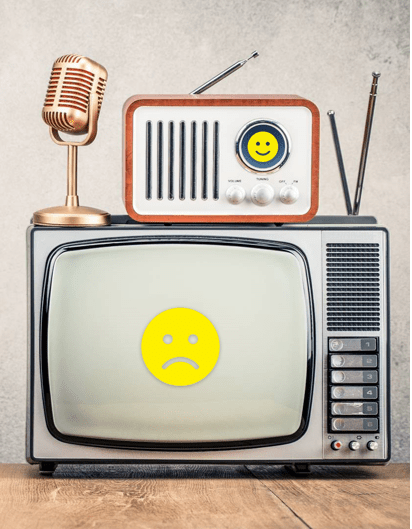
Every industry loves cliches, axioms, and tenets that help to easily describe its reality. For radio, the mantra since the rise of the Internet in the early 90s has revolved around the notion that radio people are innovative, resilient, and spry. We survived television in the 1950s and MTV in the 1980s. This Internet thing is a challenge to be sure, but don’t count radio out.
That’s obviously a reassuring balm that has made radio broadcasters feel better for the last thirty or so years. But is it true? Does one event long ago portend the same outcome years later? What was different about the attack of television in post-World War II America – and radio’s response – that was analogous to the world of online media that’s been with us now for more than three decades, spawning a tsunami of tech breakthroughs, including the iPod, smartphones, social media, podcasts, streaming audio and video, and now AI?
Not a whole lot actually. It’s not until you go back and study radio’s survival strategy when television first became ubiquitous in living rooms, rec rooms, and dens – first in black and white, and later in color – that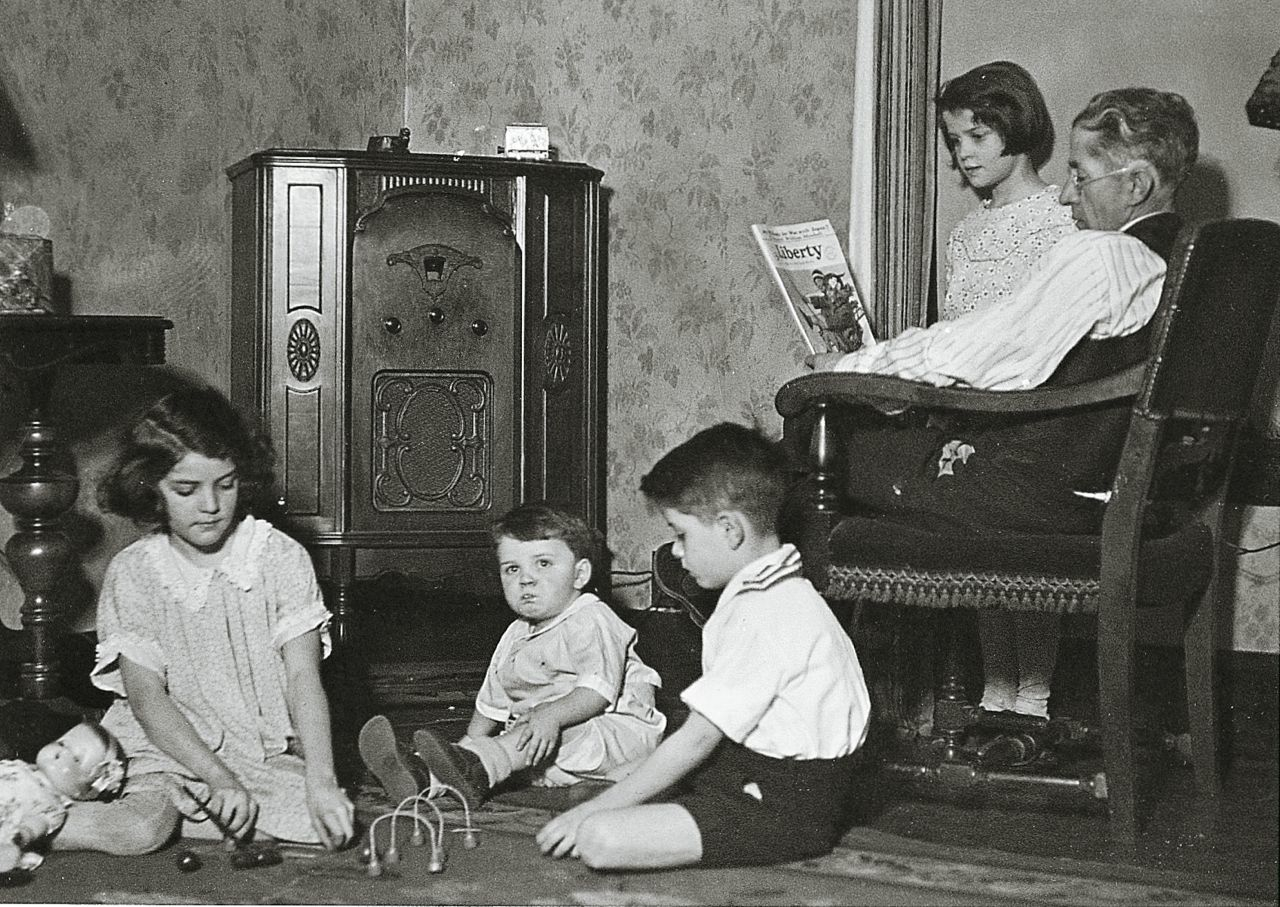 shook radio’s long-held position as the in-home entertainment and information medium. We smile at those sepia-toned photos of multiple generations of families gathered around a radio, listening to variety shows, radio dramas, comedies, and the voices of American presidents.
shook radio’s long-held position as the in-home entertainment and information medium. We smile at those sepia-toned photos of multiple generations of families gathered around a radio, listening to variety shows, radio dramas, comedies, and the voices of American presidents.
Most people in radio today don’t know this history during the momentous period when television disrupted everything. I found a succinct summary on a MacMillan higher education site, a resource for teachers. It’s a good read.
I believe that if radio is to wriggle its way out of its current conundrum, understanding how the medium coped with its previous existential challenge is important
Radio’s ability to reinvent itself in the 1950s was actually a 20+ year process. When TV’s began showing up in people’s homes, the pain point was less about the devices and much more about content. The programming/talent drain radio suffered at that time at the hands of TV was devastating. As MacMillan notes, “Remarkably, the arrival of television in the 1950s marked the only time in media history when a new medium stole virtually every national programming and advertising strategy from an older medium. Television snatched radio’s advertisers, program genres, major celebrities, and large evening audiences.”
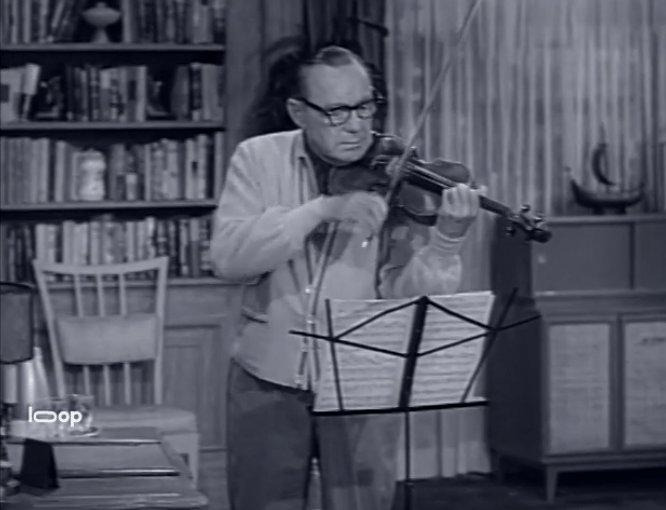
It is hard to imagine what those old radio broadcasters must have endured. Think about every mega-personality and hit show leaving the radio airwaves to instantly become fixtures on the hot new medium – television. Stars and their hit shows like George Burns and Gracie Allen, “The Lone Ranger,” and Jack Benny (pictured) led the exodus. It’s no wonder why everyone in America ran out to buy TVs. And that was the final crowning blow, of course: all those radios in millions of living rooms being replaced by television sets.
So, we think what radio has been enduring over the last decade or so has been disruptive? In many ways, it pales in comparison to what those radio pioneers had to cope with during that post-war America media boom.
So how did radio not just bounce back, but completely pivot its business model?
 The first element may have been technical. As the MacMillan piece explains, the transistor was developed by Bell Labs in the late 1940s. It was the technology that allowed radio to unshackle itself from electrical outlets to become portable.
The first element may have been technical. As the MacMillan piece explains, the transistor was developed by Bell Labs in the late 1940s. It was the technology that allowed radio to unshackle itself from electrical outlets to become portable.
Transistor radios weren’t large, expensive, or complicated, allowing consumers of all ages to take radio with them wherever they went. Unlike radio devices tethered to big vacuum tubes, transistors were tiny, allowing for radios to fit in pockets and purses. For radio broadcasters, it was a game-changer. While those lost the living room to TV, they gained portability, the ability to go anywhere.
Of course, the car radio had been around for decades, still giving radio the exclusive in cars, an advantage it still enjoys today, even with the encroachment of streaming media, satellite radio, podcasts, etc. As we know, radio is still #1 in the dashboard.
And finally, there was also the emergence of FM radio in the 1960s, thanks in part to the FCC who opened up more spectrum for stations, FM’s high quality audio, and the vision of programming pioneers who innovated compelling format radio.
This last piece – the content – is at the heart of radio’s makeover in the 50s and 60s, exploding in the 70s when FM surpassed AM in listening and revenue. Without it, all the above technology would have helped radio broadcasters, but it wouldn’t have saved them.

Radio patriarchs like Todd Storz, Gordon McLendon, and Bill Drake (with Gene Chenault) were the geniuses who envisioned the coming of format radio – essentially the same playbook radio broadcasters have run ever since.
Many credit Storz with the invention of Top 40 radio he perfected at the radio company he and his father created starting in Omaha. McClendon – also with his father – created a radio empire. He also had a hand in developing radio play-by-play starting with baseball, and creating what would become the all-news and beautiful music formats. And Drake’s “Boss Radio” became the signature sound of Top 40 radio during the era, introducing audience research and demographics to the strategic conversation.
All three of these visionaries owned stations themselves, an interesting and important distinction. They had the opportunity to experiment with their own properties, and they all brought important innovations to the changing medium that captured the hearts, minds…and ears of Americans, especially the legions of young people who became the core of the Baby Boom.
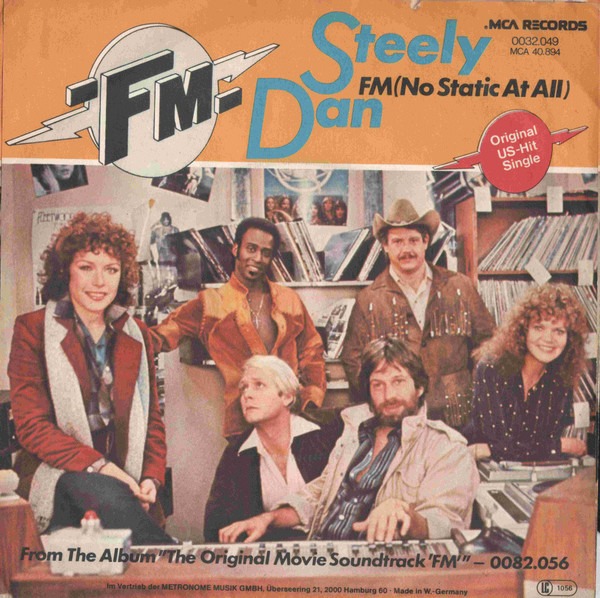
While many radio broadcasters may have been caught off guard by FM (the next disruption), most of the formats that had become popular on the AM airwaves made their way to the high quality audio provided by frequency modulation. As Steely Dan summed it up in the title song of the 1978 movie soundtrack, “FM,” these stations promised “no static at all,” a stereophonic advantage over all those AM giants.
In essence, FM was “the next big thing” for radio, an innovation that occurred within the legacy medium – not coming from the outside like streaming or social media has during the Internet Age.
With FM, the technical and programming revolution came from within. Radio broadcasters were able to control the disruption – after all, they owned the heritage AMs while learning what was going on down the hall at their FM stations. As revenue shifted from one band to the other, they were in position to reap the financial benefits.
So, can we conclude radio’s reinvention in the 50s paved the way for the medium to similarly survive the storm spawned by the Internet over the past three decades? After all, if past is prologue, doesn’t it stand to reason radio broadcasters will somehow find a way to reimagine its next iteration?
With a pedigree in innovation, radio broadcasters had the chops to handle the Internet tsunami in the same ways Drake, Storz, McLendon and so many other masterminded the TV invention to create a style of radio that would make it bigger, better, and more profitable than before.
But as we sadly know, it hasn’t happened. Radio broadcasters miscalculated in the 90s, with many writing off the Internet as something different and ultimately non-competitive. And with the passage of Telecommunication Act of 1996, the pathway toward station and market restructuring seemed ready-made for radio to reach a new pinnacle of success and domination.
But it hasn’t worked out that way. Radio broadcasters have generally done little content creation of significance in the new digital ecosphere. Nor have they innovated their existing sound pre- and post-Internet. Radio broadcasters today are generally running the same formats today as they were 30 years ago. Amazingly, radio’s reach has generally held up as consumers continue to tune-in. But digital streaming has become the conduit and radio broadcasters have been cast with playing defense.
 Why has there been so little evolution and innovation? Why have broadcasters missed the moment, unlike those aforementioned radio swashbucklers of the 1950s and 1960s who inarguably helped save radio?
Why has there been so little evolution and innovation? Why have broadcasters missed the moment, unlike those aforementioned radio swashbucklers of the 1950s and 1960s who inarguably helped save radio?
As we watch the fortunes of so many commercial radio companies falter as demand on commercial radio inventory is tepid, what are the reasons for the medium’s sputtering? And on the public radio side, stations throughout the country are engaged in painful layoffs, replacing organizational leaders, and redefining their digital content strategies.
But to what end? Are the next set of decisions going to lead to different – or better – outcomes than so many of the failed moves of the past?
Circumstances are different today than when Bill Drake – born Phillip Yarbrough – began to experiment with less DJ talk, hyper rotations on hit songs, and programming innovations like “20 20 News” to become the soundtrack of America during his heyday.
Clearly, the landscape is more crowded with technology, deep pocketed tech companies, and the expansion of media outlets and the gadgetry that delivers their content to us.
But this is all the more reason the decisions made during the second half of this year and through 2030 are more rational, strategic, and sound than the ones that have gotten us to this place.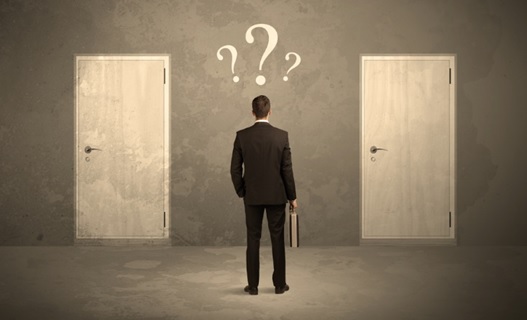
I’ve been thinking a lot about the decisions companies make to green light new content and project initiatives or to instead ride it out and wait to see what happens.
There needs to be a better, more rational, studied process in place that frames these decisions so that even the most creative people in our midst have a structure for making optimal calls.
That’s tomorrow’s blog post. And I hope you’ll read it and engage.
- For Radio, The Perils Of Rebranding - May 30, 2025
- There’s No Failure In Radio - May 29, 2025
- It’s Not An Innovation If You Can’t Make It Work – And Last - May 28, 2025




Your post provokes more questions than answers.
Is “Radio” a delivery system or a bunch of formats?
Has consolidation stifled both competition and creativity?
Is internet access a privilege or a right? Is it a utility akin to water and electrical services?
Will online services further erode advertising as a means of trying to reach profitability?
Will radio lose its preferential treatment for musical performance rights?
Will radio continue to have a prominent position in vehicle entertainment systems?
Will the quality of online audio improve to match FM broadcast?
Will the quality of AM audio continue to deteriorate?
Those are just some of the questions that will affect radio’s future. In many ways the past challenges were far simpler than the current media environment.
Excellent historical summation, Fred.
I look forward to tomorrow‘a column on the future in this multimedia era.
Thank you Fred. Time to do some serious thinking with excellent content and cost-efficient use of new technology.
Your readers may enjoy this article from Television Magazine in 1957. It’s about Todd Storz success at the beginning of Top 40. Naysayers thought “it’ll never work here”—-well, it worked
https://www.worldradiohistory.com/Archive-Miscellaneous/Archive-KOWH/Storz-Television-1957-May.pdf
An insightful read indeed, Lee. Thanks for sharing. A reminder to remember the fundamentals. Back to basics! The more things change, the more they stay the same. I’d say it starts with CONTENT and then the many ways to distribute said content in various forms, keeping in mind the contemporary philosophies you espouse.
Insightful, as always, Fred. Thanks for doing the deep dive on the way radio pivoted in the past… it certainly can spark ideas for how to handle disruption moving forward.
Great summary, Fred. I’m sure I’m not alone when I say one of the pivots needed in the future is away from the “less talk” template, (which sprouted the liner-card readers,) and more toward companionship that includes the human voice and words with meaning for the listeners (as opposed to simply parroting a station slogan.)
Dianna, alwawys good to hear from you, especially on a big topic like this one. See my earlier response. We need to do a better job training talent before just letting them key on the mic. It’s been a long time since those coaching protocols have been in place. (Sigh)
Fred, knowing the story you tell us, it would be foolish to wait for some great innovator to deliver the solution. Radio cannot sit back and wait for new Drakes and Storz to appear.
We already know how the challenges of the past were faced. This is the time for associations like NAB, RAB and all those that have to do with the media to work seriously on new proposals to move forward.
The other thing is to wait for some creative genius to come up with a new idea. The difference is that we are in the digital age, where solutions have to be given immediately…
TIto, therre is now a sense of great urgency, and yet, little is being done to innovate programming content as we’ve come to know it. Agree that radio’s biggest organizations (anad biggest broadcasters) need to join forces. Given the track record, however, we’re still waiting.
There’s a series of quotes from actor Anthony Hopkins making the rounds on social media. One of them resonates here: “We live in a packaging culture that despises content.”
Is that a chicken or egg thing? Are we not working to produce good content because we’re lazy and we think people don’t care? Or do folks not pay attention as much because there’s a lack of strong content?
I still believe strong content wins. Every time.
I agree with you, Dave. But for too many years, it was too easy for many broadcasters to turn a sizable profit, and buy/sell radio stations like flipping condos. That doesn’t create enough incentive to be more innovative with the product. And here we are.
The transistor did help save radio and pushed it to a younger on the go generation. Too bad FM was not included in celphones from the beginning. After all,the cellphone did become the transistor radio of a whole new generation. There are also national emergency notification issues that may someday prompt a change in the current policy. Good luck it’s more profitable to only offer I tunes than to offer good local FM.
Coudlda, shoulda, woulda, David. That FM chip in cell phones could’ve made the difference, BUT the onus would have still been on broadcasters to step up and make better content. Given the false sense of security from consolidation and crazy/big profit margins, it is debatable whether that wouldn’ve happened.
Here is what worries me most. With a “less talk, more music” approach it’s easier to get an audience (provided they know you are there, which is a whole different — and potentially larger — can of worms), but if we’re going to look at “creativity” as a factor alongside “companionship” I have one question which may be the stumbling block:
Do the majority of on-air talent have the ability to be creative while not going so far overboard as to drive listeners away?
My main competitor in Albuquerque has a morning person who I describe as “being able to TALK for five minutes and SAY nothing”. Does he think he is being creative? I have no idea. (The rest of the airstaff is almost as bad.)
I have a few thoughts on where we go from here, but I will wait until tomorrow’s blog to see what Fred is thinking before I post same.
So, “tommorrow” is published. LMK if I helped in any way.
But in answer to your question, we likely have a generation of people on the air who haven’t had the proper training/opportunity to be personalities. And yes, that’s a problem.
shared to my brain trust. Uno we’ve got plans & the technology but to out-maneuver all that stinkin’ Venture hype & $ is going to take more strategy and unity. See ya manaña.
Thanks for following along, Robin.
We can’t write our future without considering the little money thing. As Fred pointed out, FM in the 70’s was a fertile ground for experimentation because big brother AM carried the financial burdens. Innovative content will save the medium, but obviously that means taking risks. Venture capitalists chase risky schemes because they know a portion of them will pay out big. Not very many broadcasting companies are owned by venture capitalists. Another stimulus for innovation is when someone has a gun pointed at your head, for example Great Britain in the early 40’s. How will broadcasting get out of this mess? I want to see what Fred writes for one thing. But, there’s hope. Just look at what Red Apple Media has done with a cast-off AM station.
Thank, Dale. There is no magic formula (or I haven’t figured it out). But the toll it takes on the organization when digital content bets aren’t based on strategy is bcoming obvious. Innovation isn’t easy, but radio has to figure out how to be more strategic or face the reality of more fails.